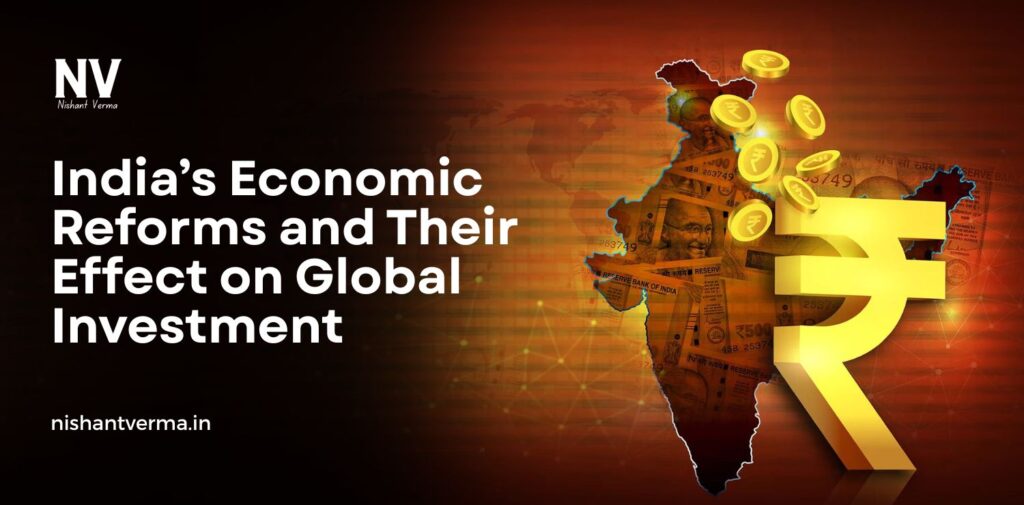India, the world’s fifth-largest economy, has undergone a series of economic reforms over the past few decades, transforming its economic landscape. These reforms have made India one of the most attractive destinations for global investment. With the country’s growing consumer market, improved business climate, and rising infrastructure, global investors are increasingly looking at India as a key player in the world economy. This article explores the impact of India economic reforms on global investment and how these changes are shaping the country’s future.
The Evolution of India Economic Reforms
India’s journey toward economic liberalization began in the early 1990s. Prior to that, the Indian economy was heavily regulated, with a focus on self-reliance and import substitution. However, in 1991, the country faced a severe economic crisis, which led to the introduction of major economic reforms. The government, led by then-finance minister Dr. Manmohan Singh, adopted a series of measures to open up the economy, reduce fiscal deficits, and encourage foreign investment.
These early reforms included the devaluation of the rupee, the reduction of import tariffs, and the deregulation of several industries. Over the years, these policies were followed by further steps aimed at simplifying the tax system, improving the ease of doing business, and creating a more open and competitive market. Some key reforms like the Goods and Services Tax (GST), Make in India initiative, and Digital India program have further accelerated the country’s economic growth and attracted global attention.

Impact of GST on Business Environment
One of the most significant reforms in recent years has been the introduction of the Goods and Services Tax (GST) in 2017. Prior to GST, India had a complex tax structure with multiple layers of taxation, including state-level sales tax and central excise duties. This system created a lot of inefficiencies, hampered interstate trade, and led to high compliance costs for businesses.
With the introduction of GST, the country moved to a single, unified tax structure. This has made business operations smoother and more efficient by eliminating the cascading effect of taxes, reducing logistical costs, and encouraging greater compliance. As a result, India has become a more attractive place for foreign businesses to set up operations, particularly in sectors like retail, manufacturing, and e-commerce. The simplification of the tax system has also made it easier for both domestic and global investors to navigate the market.
Make in India: A Push for Manufacturing and Foreign Investment
Another key initiative that has had a major impact on global investment in India is the Make in India campaign. Launched in 2014, this initiative aimed to transform India into a global manufacturing hub by promoting domestic production and attracting foreign direct investment (FDI). The government made several policy changes to improve the ease of doing business in India, including simplifying labor laws, offering tax incentives, and reducing bureaucratic red tape.
The Make in India initiative has proven successful in attracting significant investment from multinational companies. For example, companies like Samsung, Apple, and Foxconn have set up or expanded their manufacturing facilities in India. This not only creates jobs but also helps to boost India’s export capacity, reduce its trade deficit, and improve its technological capabilities.
Foreign investors are also drawn to India’s growing middle class and its vast consumer market. As the country’s population continues to rise, there is an increasing demand for a wide range of products, from consumer goods to electronics and automobiles. With the government’s support for the manufacturing sector, foreign companies are eager to tap into this burgeoning market.

Digital India: The Role of Technology in Attracting Investment
India has also embraced digital transformation through its Digital India initiative. Launched in 2015, this program aims to improve the country’s digital infrastructure, increase internet connectivity, and promote online governance and services. The growth of India’s tech sector has been one of the most striking aspects of the country’s economic reforms.
India’s digital economy has seen significant growth, with more and more people gaining access to the internet and mobile phones. This has opened up new opportunities for foreign investors in the tech, e-commerce, and digital services sectors. Global giants like Amazon, Google, and Microsoft have heavily invested in India, recognizing the country’s vast potential in the digital space.
Moreover, the government’s push for digitization has made it easier for businesses to operate in India, allowing for smoother transactions, digital payments, and better access to information. The rise of fintech companies and digital startups has created a vibrant ecosystem for innovation, attracting venture capital and private equity from around the world.
Infrastructure Development: Building a Strong Foundation for Investment
A crucial aspect of India economic reforms has been the emphasis on improving the country’s infrastructure. The government has invested heavily in roads, ports, airports, and power generation to create a more conducive environment for business. Infrastructure development not only makes it easier for businesses to operate but also plays a key role in attracting global investors.
India’s National Infrastructure Pipeline (NIP), which includes investments in sectors like energy, transportation, and urban development, aims to drive economic growth and create employment opportunities. This large-scale infrastructure development has made the country more accessible to foreign investors, particularly in industries such as logistics, real estate, and construction.
Additionally, the government has been working to improve urban infrastructure through programs like Smart Cities Mission and Atal Mission for Rejuvenation and Urban Transformation (AMRUT), which focus on creating sustainable, well-connected cities. The improvement of urban infrastructure makes it easier for businesses to establish their presence in major cities and expand across the country.
India’s Role in the Global Economy and Future Outlook
India economic reforms have positioned the country as a key player in the global economy. The country’s large market size, competitive workforce, and expanding infrastructure make it an attractive destination for foreign investment. India’s integration into global supply chains and its growing role in international trade have also contributed to the country’s increased importance on the world stage.
The Indian government has set ambitious targets for the country’s economic future. By 2025, India aims to become a $5 trillion economy, a goal that would further boost its role in global investment. The continued push for reforms in labor laws, land acquisition, and tax policies will further improve the business environment and make India an even more attractive destination for global capital.
Additionally, India’s growing influence in sectors like renewable energy, artificial intelligence, and space technology offers new opportunities for international investors. The government’s support for innovation, research, and development is likely to attract further investment in these cutting-edge industries.

Challenges and the Path Ahead
While India economic reforms have made significant progress, challenges remain. One of the key obstacles to attracting more global investment is the complex regulatory environment. Although reforms have made doing business easier, bureaucratic hurdles and lengthy approval processes still exist in some sectors. The government needs to focus on further simplifying the regulatory framework to make it easier for foreign investors to navigate.
Another challenge is the uneven distribution of economic growth across the country. While cities like Mumbai, Delhi, and Bengaluru have become major investment hubs, other regions still face issues related to infrastructure, education, and healthcare. Ensuring that growth is inclusive and benefits all parts of the country will be key to India’s continued success as an investment destination.
Conclusion
India economic reforms have played a pivotal role in transforming the country into one of the most attractive destinations for global investment. With initiatives like GST, Make in India, Digital India, and massive infrastructure development, India has created a more conducive environment for businesses and investors. While challenges remain, the country’s continued push for reforms and its growing global influence make it an exciting market for international capital. As India moves toward becoming a $5 trillion economy, the impact of its economic reforms on global investment will only continue to grow, opening up new opportunities for businesses around the world.




